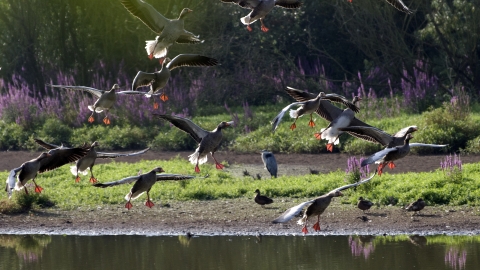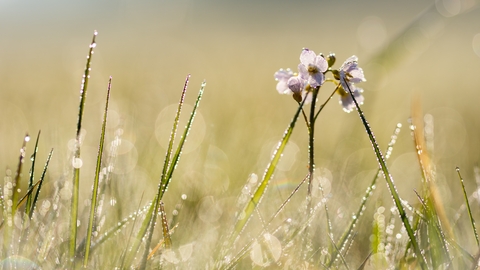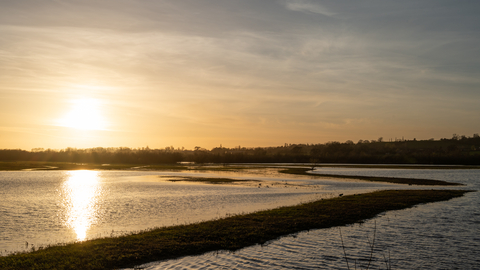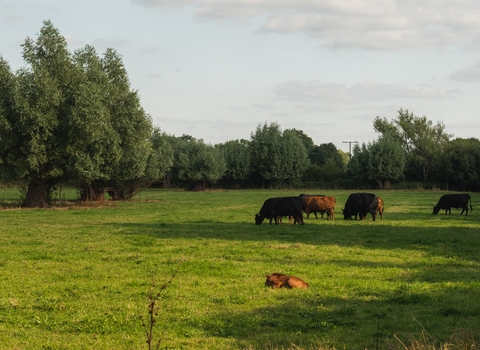
Zsuzsanna

Cuckoo flowers at dawn (c) Mark Cox

Coombe Hill (c) Nathan Millar
Coombe Hill Canal and Meadows
Coombe Hill Canal and Meadows is a place of vistas and endless skies, of floods and farming, an ancient landscape fringing the River Severn. Whether it’s a chilly autumnal morning or warm summer’s day, there’s always something to delight visitors at Coombe Hill. This wetland landscape is great for walking and bird watching, although acts as a floodplain during winter months. Bring binoculars to bird watch, or sit and enjoy the wildlife and scenery.
Location
Know before you go
Dogs
When to visit
Opening times
Open access throughout the yearBest time to visit
Throughout the year, although may be inaccessible during times of floodingAbout the reserve
This historic wet grassland landscape in the Severn Vale is a very special site. In summer its lush pasture is bejewelled with wildflowers, attracting a variety of butterflies and used by ground-nesting birds. In winter the reserve serves as a floodplain, with the high water attracting spectacular numbers of over-wintering wildfowl.
The River Severn Navigation Canal runs close by, and there are a number of deep ditches and pools, both of which are popular with dragonflies and damselflies. Over 17 species have been recorded here including the hairy dragonfly, scarce chaser and emperor dragonfly.
History
Coombe Hill nature reserve has long been used for summer grazing by farmers in the Severn Vale. The reserve was adopted by Gloucestershire Wildlife Trust in 2000 and has expanded over the years. Severe flooding during the summer of 2007 led the Trust to embark on one of its biggest restoration projects. Public appeals and the generosity of Coombe Hill Patrons helped improve access within the reserve. Work carried out includes the extension to the boardwalk up to the Grundon bird hide, completed in 2010.
Famous for
One of the best spots in Gloucestershire to see dragonflies and damselflies and to watch birds, with the Grundon hide overlooking the main wetland area. Bring binoculars or simply sit back and enjoy the wildlife.
This nature reserve is particularly special, as well as it being an important haven for wildlife, it also acts a floodplain. The woodlands and grasslands here have adapted to being completely submerged by water in winter months, capturing water that would otherwise flood out other areas, while also trapping sediment and storing carbon.
It is a very special site for wetland birds, particularly waders and migrating waterfowl, but also watch out for birds of prey, including hen harriers, peregrine falcons and goshawks. Snipe, redshanks, oystercatchers, lapwings and curlews are just a few of the many birds sighted here.
This reserve is a haven for ground-nesting birds, which are easily disturbed by dogs and people. For this reason, we ask for dogs to be kept on a lead during the birds breeding season which falls between March and September. By sticking to the paths and waymarked trails, visitors can help minimise startling any wildlife.
Species
Environmental designation
Taking care of wildlife at Coombe Hill
Please take extra care while ground-nesting birds are active, avoid walking across these areas and keep dogs on leads.
More detailed directions
Head north out of Gloucester on the A38 towards Tewkesbury. Carry on through Twigworth and then through Norton. Continue on A38 until you reach a cross roads with a set of traffic lights and the Swan Inn pub. Turn left at traffic lights down a dead end single lane track. The car park is at the bottom of the track.
Accessibility
Take extra care in autumn when the nature reserve can get wet and muddy and be mindful of the pools and deep ditches.
The path along the canals can become unsuitable for wheelchairs or pushchairs during wet periods.
Then is one bench at the first bridge, and one in the shape of a dragonfly on the other side of the canal to the car park.
In winter Coombe Hill is inaccessible as it is an active floodplain.
How to find the Wigeon and Teal bird hides and walking routes
The Wigeon - formerly Grundon - hide is accessed via a boardwalk from the towpath and overlooks the main breeding grounds. Cross the canal using the path or road just before the entrance of the car park, then follow the tow path for 1km, this will lead you to the board walk, which will be on your right. Alternatively follow the tow path from the car park, then cross the first bridge over the canal. Turn left and continue for 400m to reach the board walk.
There is a 1.2km 'Dragonfly' walk from the wharf car park, along the towpath, over the first bridge and return on the opposite side of the canal. This is flat, although can get quite rutted due to it being a bridleway and the volume of people using the path.
A longer 2.4km return walk takes you to the Grundon bird hide which overlooks the main wetland features. A further 'Curlew' walk of 4.5km takes you around the north meadows on a permissive right of way. This is waymarked but the posts can be difficult to spot when the meadow grass has grown.
Follow the Curlew walk and relevant waymarkers for access to the Teal hide.








